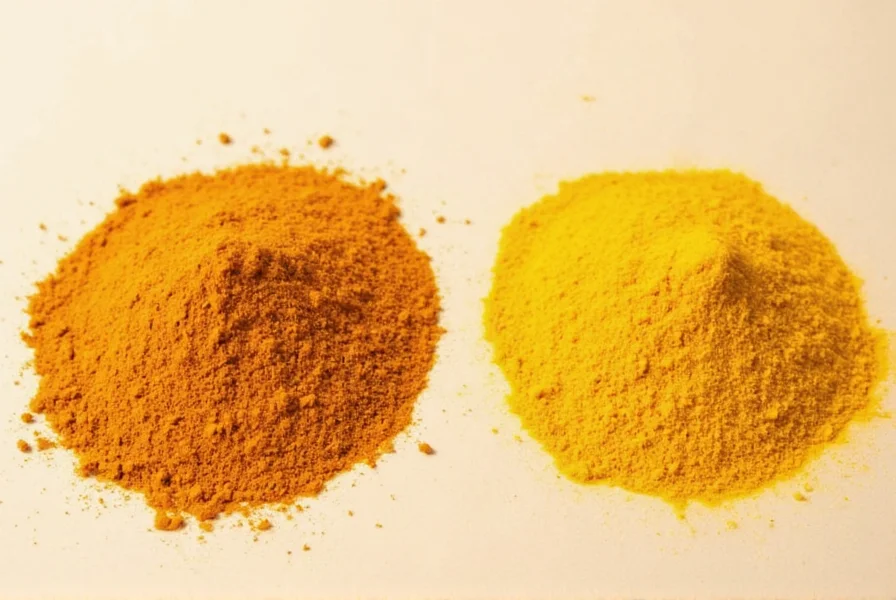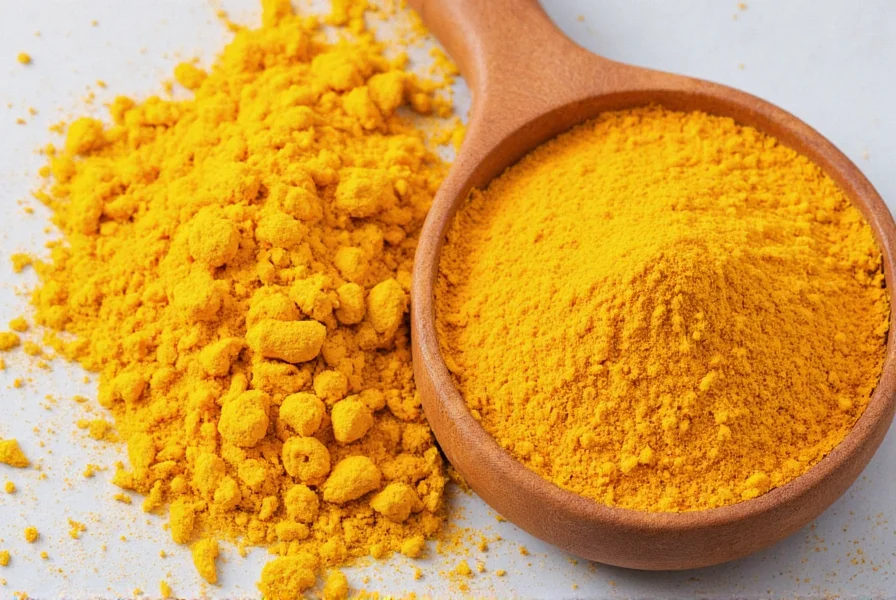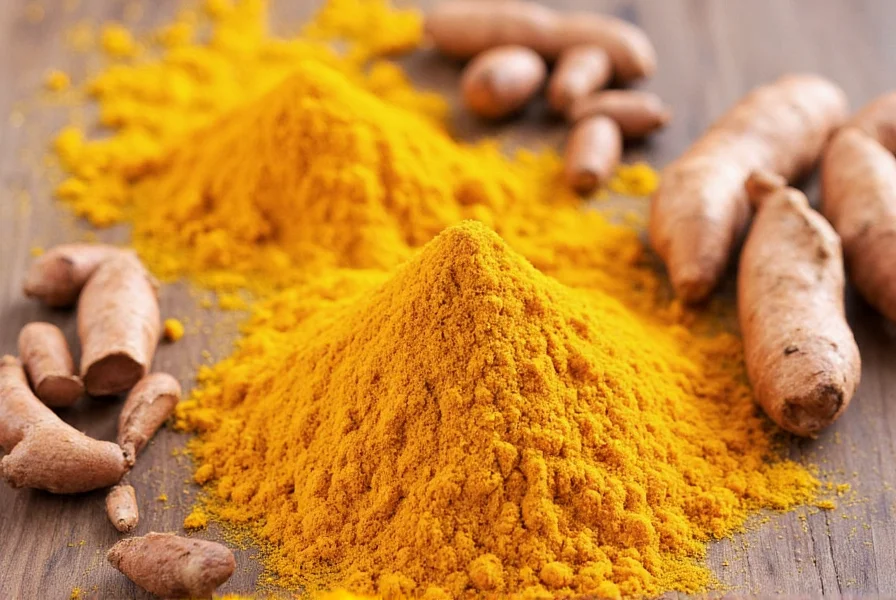Many people mistakenly use the terms "turmeric" and "curcumin" interchangeably, but they represent distinctly different entities in both composition and application. This confusion often stems from marketing practices in the supplement industry, where curcumin's prominence in scientific research has led to its frequent mention as the "active ingredient" in turmeric.
What Exactly Is Turmeric?
Turmeric (Curcuma longa) is a flowering plant in the ginger family, native to Southeast Asia and India. The part used as a spice is the rhizome (underground stem), which is boiled, dried, and ground into the familiar yellow-orange powder. For thousands of years, turmeric has been used in traditional Ayurvedic and Chinese medicine, as a culinary spice in South Asian cuisine, and as a natural dye.
Chemically, turmeric contains over 100 different compounds, collectively known as curcuminoids. These include:
- Curcumin (diferuloylmethane) - approximately 77% of curcuminoids
- Demethoxycurcumin - about 17%
- Bisdemethoxycurcumin - around 3-6%
Besides curcuminoids, turmeric also contains essential oils (like turmerone), proteins, resins, and sugars. This complex composition means that turmeric offers a broader spectrum of compounds than isolated curcumin alone.
What Is Curcumin Specifically?
Curcumin is the most studied and biologically active compound within turmeric, responsible for its vibrant yellow color and much of its researched health properties. Scientific interest in curcumin has grown substantially, with thousands of peer-reviewed studies examining its potential anti-inflammatory and antioxidant effects.
When researchers study "turmeric" in clinical settings, they're often actually studying standardized curcumin extracts, typically containing 95% curcuminoids. This research focus has contributed significantly to the common misconception that turmeric and curcumin are identical.
| Characteristic | Turmeric | Curcumin |
|---|---|---|
| Nature | Whole spice from Curcuma longa plant | Single chemical compound |
| Composition | Contains curcuminoids (2-8%), essential oils, fibers, and other compounds | One specific polyphenol (diferuloylmethane) |
| Concentration in Turmeric | N/A (the whole substance) | Approximately 2-8% by weight |
| Primary Uses | Culinary spice, traditional medicine, dye | Research subject, dietary supplements |
| Bioavailability | Naturally low, enhanced when consumed with black pepper or fats | Even lower when isolated, often formulated with absorption enhancers |
Why the Confusion Persists
The persistent confusion between turmeric and curcumin stems from several factors in both scientific literature and consumer markets. When examining the difference between turmeric and curcumin in supplements, it's important to understand that most clinical research investigating "turmeric" benefits has actually used concentrated curcumin extracts.
Supplement manufacturers often capitalize on this by labeling products as "turmeric" while prominently featuring "curcumin" content percentages. This marketing approach has led many consumers to believe they're getting the same thing, when in reality, they're purchasing different products with different compositions.
Another contributing factor is that curcumin represents the most pharmacologically active component of turmeric, responsible for many of the health benefits attributed to the spice. However, emerging research suggests that other components in turmeric may work synergistically with curcumin, potentially enhancing its effects—a concept known as the "entourage effect."

Health Implications of the Distinction
Understanding whether turmeric and curcumin are the same matters significantly when considering potential health applications. Most clinical studies showing benefits for inflammation, joint health, or cognitive function have used standardized curcumin extracts at doses of 500-2,000 mg daily—amounts that would require consuming impractical quantities of regular turmeric powder.
For example, to obtain 1,000 mg of curcumin from regular turmeric powder (assuming 3% curcumin content), you would need to consume approximately 33 grams of turmeric—more than 6 teaspoons. This is why many therapeutic studies use concentrated extracts rather than the whole spice.
Additionally, curcumin's notoriously poor bioavailability means that even when consumed in supplement form, special formulations are often needed to enhance absorption. Common approaches include combining curcumin with piperine (from black pepper), using liposomal delivery systems, or creating phospholipid complexes.
Practical Considerations for Consumers
When evaluating turmeric products, understanding the difference between turmeric and curcumin can help you make informed choices. Culinary turmeric powder typically contains only 2-8% curcuminoids, while supplements may offer standardized extracts containing 95% curcuminoids.
If you're using turmeric for cooking, regular turmeric powder provides the full spectrum of compounds naturally present in the spice. However, if you're seeking potential therapeutic benefits studied in clinical research, you'll likely need a concentrated curcumin supplement with enhanced bioavailability.
It's also worth noting that whole turmeric contains other beneficial compounds beyond curcumin. Turmerones, for instance, have shown potential neuroprotective effects in preliminary research. This suggests that for some applications, the whole spice might offer benefits beyond what isolated curcumin provides.

Scientific Context and Research
When examining scientific literature about turmeric versus curcumin, pay close attention to whether studies used whole turmeric or isolated curcumin. Many studies investigating the health benefits of turmeric actually employed curcumin extracts, which has contributed to the ongoing confusion.
Research suggests that while curcumin is the most active compound, other components in turmeric may contribute to its overall effects. Some studies indicate that the full spectrum of curcuminoids (curcumin, demethoxycurcumin, and bisdemethoxycurcumin) may work together more effectively than curcumin alone—a phenomenon researchers call "combinatorial activity."
Furthermore, the essential oils in turmeric, particularly ar-turmerone, have demonstrated biological activities independent of curcumin. This complexity highlights why understanding the distinction between turmeric and curcumin matters for both consumers and researchers.
Conclusion
The question "is curcumin the same as turmeric" has a clear answer: no, they are not identical. Turmeric is the whole spice containing numerous compounds, while curcumin is just one specific compound within turmeric. Recognizing this difference is essential for understanding product labels, interpreting research findings, and making informed decisions about culinary and potential health applications.
Whether you're using turmeric in your cooking or considering curcumin supplements for potential health benefits, knowing what you're actually consuming helps set realistic expectations about effects and appropriate usage. The next time you see these terms, remember that curcumin is a component of turmeric—not synonymous with it.
Frequently Asked Questions
Does turmeric contain curcumin?
Yes, turmeric contains curcumin as its primary active compound, but only in concentrations of approximately 2-8% by weight. Turmeric actually contains a group of compounds called curcuminoids, with curcumin making up about 77% of these curcuminoids, while demethoxycurcumin and bisdemethoxycurcumin account for the remainder.
Which is better for health: turmeric or curcumin?
The answer depends on your goals. For culinary use and general wellness, whole turmeric provides a broader spectrum of compounds. For targeted therapeutic applications studied in research, standardized curcumin extracts (often with enhanced bioavailability) are typically used, as regular turmeric doesn't contain enough curcumin to achieve the doses used in most clinical studies. Emerging research suggests potential benefits from the full spectrum of compounds in turmeric working together.
Can I get enough curcumin from cooking with turmeric?
It's unlikely. Most clinical studies showing potential health benefits use 500-2,000 mg of curcumin daily. Since turmeric contains only 2-8% curcumin by weight, you would need to consume 25-100 grams of turmeric powder daily to reach these levels—far more than used in cooking. A typical curry might contain 1-3 grams of turmeric, providing only 20-240 mg of curcumin. For therapeutic doses, supplements are generally necessary.
Why do supplement labels say "turmeric" when they contain curcumin?
This is primarily a marketing practice. Since turmeric is the well-known source, manufacturers often lead with that familiar term while specifying the curcumin content in smaller print. Legitimate supplements should clearly state both the turmeric extract amount and the standardized curcumin percentage (e.g., "Turmeric Extract (root) 500mg, standardized to 95% curcuminoids"). Always check the supplement facts panel for specifics.
Does black pepper increase the absorption of both turmeric and curcumin?
Yes, piperine (the active compound in black pepper) enhances the bioavailability of curcumin specifically. Since curcumin is the primary compound of interest in turmeric for many health applications, adding black pepper to turmeric-containing dishes can increase absorption of curcumin. This effect applies to both culinary turmeric and curcumin supplements, which is why many curcumin products include piperine or state they're "with black pepper extract" for enhanced absorption.











 浙公网安备
33010002000092号
浙公网安备
33010002000092号 浙B2-20120091-4
浙B2-20120091-4